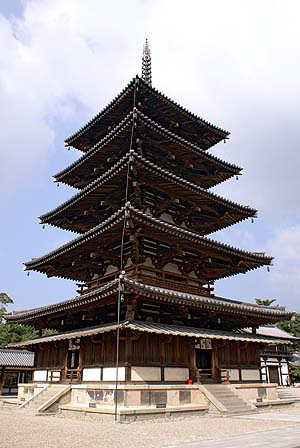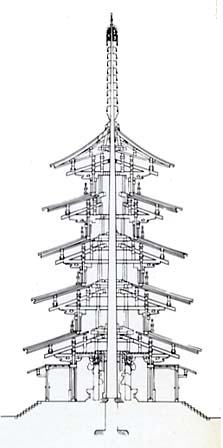


image source: Kidder, p. 59

|

|

image source: Kidder, p. 59 |
Horyuji Temple
Ikaruga, Japan
Horyuji Temple, a royal foundation of Prince Shotoku (who built his palace on the grounds), was completed in 607, burnt to the ground by lightning in 670, rebuilt in 711, and has endured multiple episodes of destruction and restoration in the following centuries. So if its pagoda and kondo are among the oldest wooden buildings in the world, what does this actually mean? That however damaged, the temple has always been carefully rebuilt according to its original plan, while reusing as much of its original material as possible. The human body continually replaces its cells, yet it is still the same body. Fresh water flows daily through a river, yet it is still the same river.
The stories of the pagoda decrease in size from bottom to top. Its 100-foot-tall structure is built around a massive internal pole that was cut from a single tree trunk in 594 A.D., although Kidder (p. 64), writes that "If anything, the pagoda supports the pole, not the pole the pagoda."
The pagoda form was originally derived from Chinese watchtowers. However, unlike the Chinese pagoda, this early Japanese example does not have functional upper floors (the balconies are merely decorative, you can't climb up there and look out). The stone platform that supports this and other temple buildings is also derived from Chinese models. And the same is true of the Kondo (later page). Amazingly, all of this impressive and beautiful temple architecture seems to have been recreated from illustrations (exteriors-only) in Chinese picture-books, without direct knowledge of the Chinese originals.
A multitude of stunning miniature clay statues (next page) are displayed in four alcoves that are set into the outside of the pagoda's walls.

|

|

|